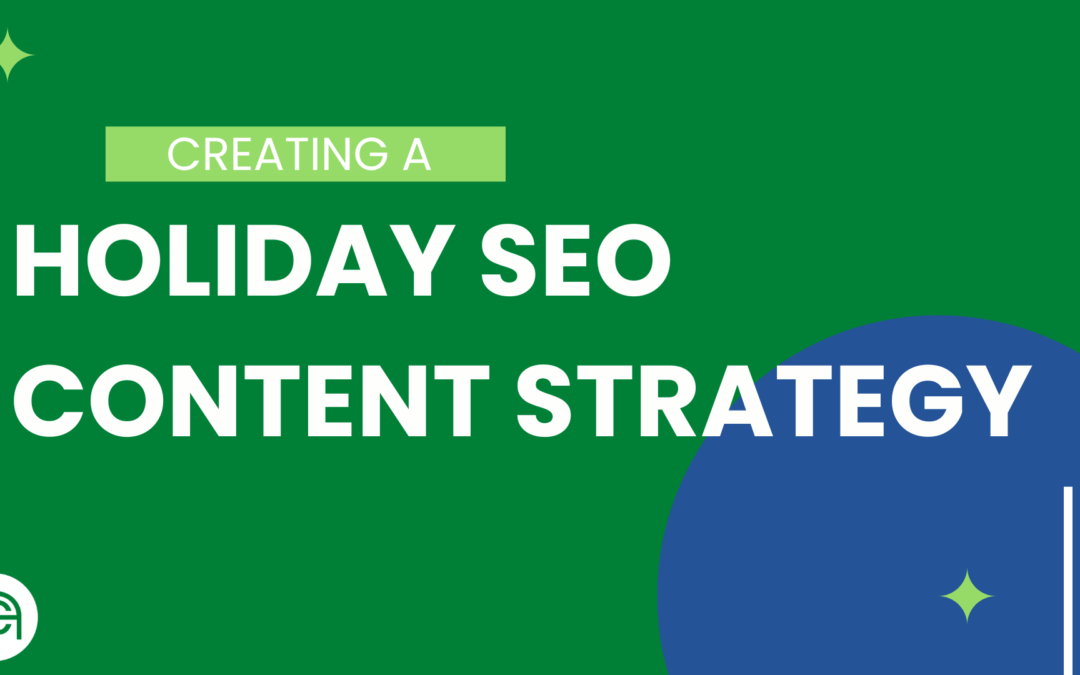Set Your Website Up for Success with a Holiday Content Strategy
Although the final dog days of summer are just beginning to fade and temperatures are still hovering in the upper 80s, it is never too early to start planning for the holiday season. This holds especially true for brands, marketers, and SEO specialists. In fact, 51 percent of shoppers have indicated that they plan to start shopping earlier this holiday season, while 19 percent have already begun, according to a May 2022 Google consumer pulse survey.
What to Know about Holiday Content Marketing
The uptick in traffic and sales that comes with the holiday shopping season is an excellent opportunity to stand out from your competitors and increase your brand awareness. Not only are consumers on the lookout for gifts, but also for content that meets their unique needs and guides them toward the perfect purchase.
Your long term strategy and approach to search engine optimization should altogether encompass your seasonal-based efforts. Your site should also always provide an optimal user experience with relevant content and up-to-date technical best practices. There are, however, some emerging holiday-centric tactics to take into account. Customers behave differently during this season of gift-giving, so here are some valuable tips for creating a winning content strategy for the holidays.
8 Strategies for Optimizing Your SEO Content for the Holidays
1. Tailor Your Content to Your Consumer
As is the case with all SEO content creation, your content strategy must match the search intent of consumers looking for products and services like yours. Ensure that your holiday content marketing strategy aligns your existing business goals with meeting the needs of your customers. More than 70 percent of people indicated that they would rather receive information from a company via an article or blog post than a traditional advertisement. Use this insight to guide your content creation and consider the channels that would be most effective for your brand, whether it be social media, email marketing, an on-site blog, or a combination.
Your holiday season marketing content needs to align with your business and maintain a consistent brand voice and tone — perhaps even a touch lighter and more cheerful than usual. Make sure to assess top priorities and timelines when preparing your holiday content promotional calendar and do so in advance. If you are producing multiple pieces of content for one holiday, the material should follow a chronological progression and be ready for launch before the holiday itself.
2. Analyze Trends from Years Past
While the holiday season comes around annually, a successful holiday marketing strategy does not consist of reusing the same stale content every year. Take a data-centric approach in projecting what your holiday organic search traffic might look like for the holiday season. A great place to start is with Google’s trends tool to get a sense of what products and categories are preparing for a big breakout or decline in consumer interest. Then, analyze your own site’s data from Google Search Console and Google Analytics. Make note of which pages generated the most traffic during the last holiday season and which channels and queries drove the most traffic.
It’s critical to be aware of any trends that might be developing within the geographical areas you serve or product categories you compete in. Finding out which product or service categories might take off next can be discovered by researching trends, completing social listening analysis or digging into Google Business insights.
3. Invest in Your Keyword Strategy: From Broad to Long-Tail
You probably already know that keyword research is one of the most critical parts of a successful SEO strategy, but the pressure is increased during the ultra-competitive holiday shopping season. When doing keyword research, start with your historic data to see if you can find interesting and relevant keywords that consumers used to find you in years past. The sweet spot is finding keywords with relatively large volume, but highly targeted user intent.
This holiday season, shoppers are open, yet specific. According to data from Google, half of shopping searches start broadly (i.e. “top holiday toys”), but 75 percent of shoppers say they only want to see ads and results that are relevant and useful. You shouldn’t necessarily be afraid to go after those broader shoppers (especially if you offer A+ content and products), but definitely don’t forget to consider long-tail keywords. Honing in on those regionally specific or question-based keywords can be a winning strategy, especially for smaller brands.
4. Assess Your Technical Capabilities
Make sure the infrastructure of your website can withstand the increased traffic during the holidays. We know that page speed is crucial to driving traffic, conversions, and consumer satisfaction. In fact, Google rewards merchants who are offering the most ideal and optimized experiences with more visibility across search, local, and mobile. With the launch of Core Web Vitals and Google’s page experience update, it’s easy to create a checklist for optimizing your website’s technical performance. When conducting an audit, it is crucial to consider website loading speed, mobile-friendliness, broken URLs, site indexing, outdated or redundant web pages, image compression and more.
If you have plans to migrate your site or carry out other significant site improvements, now is the time to do it — as long as you can complete the process prior to the holidays. If you launch any later, you will have less time to resolve errors and fewer opportunities to test your site on customers. After all, implementing modifications that have a negative impact on conversion rates just before the busiest shopping season of the year is the last thing you want to do.
5. Refresh and Revisit Your Evergreen Posts
Yes, you definitely need brand new, relevant content as each holiday season rolls around, but that doesn’t mean you can’t repurpose already successful campaigns from years past. Older evergreen content, like holiday gift guides, can be spruced up with new images and trendier products. The better this content is, the more links it can gain for you, better positioning you to gain traffic year after year. Audit your past content and get creative when it comes to updating your messaging for this year’s audience.
Another great tip is to create evergreen seasonal URLs. For example, choose “/new-years-deals” instead of “/2023-new-years-deals.” This way, the page can be repurposed and maintain authority and links that build up over time. If necessary, don’t forget to update title tags, header and copy and request Google recrawl the page after a refresh.
6. Plan for the Major Events
The holidays are both a marathon and a series of sprints. While you might view November and December as one endless blur of shopping and deals, consumer behavior actually ebbs and flows alongside major events. Think Black Friday, Cyber Monday, the countdown to Christmas, Hanukkah, Kwanzaa, New Year’s Eve and more. There are opportunities to plan sales around and generate traffic for each of these terms.
You will likely want to create dedicated landing pages that target these keywords, depending on what products and deal types are trending in your product vertical. You can create these pages well in advance and use a temporary 302 redirect to hide the pages until you need them. This will give you plenty of time to prepare for holiday shoppers and gives web crawlers time to browse the site. Just be sure to add any new landing pages to your XML sitemap and navigation.
7. Don’t Forget About Giving Back
Think about the most memorable holiday content—commercials, movies, TV shows, even songs—what do they have in common? In most cases, it’s the warm and fuzzy messages and feelings they evoke. While it’s easy to get caught up in the commercial deals and shopping side of the season, philanthropy and giving back are also big parts of what makes this time of year so meaningful.
Does your brand engage in charitable outreach? If so, the holidays are a great time to get vocal about your efforts. Highlighting your business alongside its core values is an excellent way to build brand trust and affinity and stand out in a crowded marketplace. Storytelling beyond your product features is one of the most important parts of customer retention and loyalty.
8. Wrap it Up With a Year-in-Review
One type of content that trends widely across industries is the year in review. This makes sense as it’s a fantastic way to meaningfully connect with your customers. The most successful of these campaigns is Spotify Wrapped, which engages more than 90 million people annually. While you might not collect the same data—or have the same size consumer base—as the music giant, the holidays are a good time to take a look back and deepen your connection with your audience.
A year-in-review is a great place for visual and storytelling experimentation, and an opportunity to resonate with consumers who have helped shape your brand. Remind your audience of past wins and product launches and generate excitement about what’s to come in the future.
Looking Ahead
The holidays can be an overwhelming time for SEO professionals, consumers and brands alike, but a timely and relevant holiday content strategy can ease the concerns of all parties involved. Keep in mind that any tips you collect this year can be used to strengthen your strategy and planning process so you’re prepared when next season rolls around. Good luck and happy holidays!


